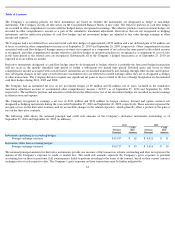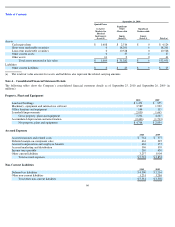Apple 2010 Annual Report Download - page 63
Download and view the complete annual report
Please find page 63 of the 2010 Apple annual report below. You can navigate through the pages in the report by either clicking on the pages listed below, or by using the keyword search tool below to find specific information within the annual report.
Table of Contents
The following tables show the gross unrealized losses and fair value for investments in an unrealized loss position as of September 25, 2010 and
September 26, 2009, aggregated by investment category and the length of time that individual securities have been in a continuous loss position
(in millions):
The Company considers the declines in market value of its marketable securities investment portfolio to be temporary in nature. The unrealized
losses on the Company’
s marketable securities were caused primarily by changes in market interest rates or widening credit spreads. The
Company typically invests in highly-
rated securities, and its policy generally limits the amount of credit exposure to any one issuer. The
Company’s investment policy requires investments to be investment grade, primarily rated single-
A or better, with the objective of minimizing
the potential risk of principal loss. Fair values were determined for each individual security in the investment portfolio. When evaluating the
investments for other-than-
temporary impairment, the Company reviews factors such as the length of time and extent to which fair value has
been below cost basis, the financial condition of the issuer and any changes thereto, and the Company’
s intent to sell, or whether it is more likely
than not it will be required to sell, the investment before recovery of the investment’
s amortized cost basis. During the years ended
September 25, 2010 and September 26, 2009, the Company did not recognize any significant impairment charges. As of September 25, 2010, the
Company does not consider any of its investments to be other-than-temporarily impaired.
Derivative Financial Instruments
The Company uses derivatives to partially offset its business exposure to foreign currency exchange risk. The Company may enter into foreign
currency forward and option contracts to offset some of the foreign exchange risk of expected future cash flows on certain forecasted revenue
and cost of sales, of net investments in certain foreign subsidiaries, and on certain existing assets and liabilities. To help protect gross margins
from fluctuations in foreign currency exchange rates, certain of the Company’
s subsidiaries whose functional currency is the U.S. dollar, hedge a
portion of forecasted foreign currency revenue. The Company’
s subsidiaries whose functional currency is not the U.S. dollar and who sell in
local currencies, may hedge a portion of forecasted inventory purchases not denominated in the subsidiaries’
functional currencies. The
Company typically hedges portions of its forecasted foreign currency exposure associated with revenue and inventory purchases for three to six
months. To help protect the net investment in a foreign operation from adverse changes in foreign currency exchange rates, the Company may
enter into foreign currency forward and option contracts to offset the changes in the carrying amounts of these investments due to fluctuations in
foreign currency exchange rates. The Company may also enter into foreign currency forward and option contracts to partially offset the foreign
currency exchange gains and losses generated by the re-measurement of certain assets and liabilities denominated in non-
functional currencies.
However, the Company may choose not to hedge certain foreign currency exchange exposures for a variety of reasons, including but not limited
to immateriality, accounting considerations and the prohibitive economic cost of hedging particular exposures. There can be no assurance the
hedges will offset more than a portion of the financial impact resulting from movements in foreign currency exchange rates.
60
September 25, 2010
Less than 12 Months
12 Months or Greater
Total
Fair
Value
Unrealized
Losses
Fair
Value
Unrealized
Losses
Fair
Value
Unrealized
Loss
Certificates of deposit and time deposits
$
802
$
(1
)
$
54
$
0
$
856
$
(1
)
Corporate securities
3,579
(7
)
275
(2
)
3,854
(9
)
Municipal securities
298
(1
)
0
0
298
(1
)
Total
$
4,679
$
(9
)
$
329
$
(2
)
$
5,008
$
(11
)
September 26, 2009
Less than 12 Months
12 Months or Greater
Total
Fair
Value
Unrealized
Losses
Fair
Value
Unrealized
Losses
Fair
Value
Unrealized
Loss
Corporate securities
$
1,667
$
(3
)
$
719
$
(13
)
$
2,386
$
(16
)
























